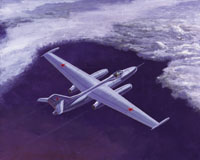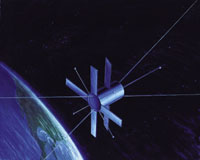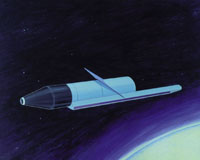|
Reconnaissance Systems
The United States and
the Soviet Union used many different reconnaissance systems during
the Cold War. Some imaged military targets, others detected radar
and radio emissions, and still others intercepted communications.
Advances in technology enabled both nations to conduct these missions
from the relative safety of space beginning in the 1960s. Soviet
systems provided military and political leaders with information
on U.S. military forces and developments.
|
 |
Mandrake
American U-2 overflights
of Soviet territory in the late 1950s prompted the Soviet Union
to develop its own high-altitude reconnaissance aircraft, the Yak-25RD
Mandrake, which is depicted in this 1972 illustration. Unlike the
U-2, the Soviets designed the Mandrake around an existing airframe,
the all-weather Yak-25 interceptor. Carrying cameras and signals
intelligence equipment, the Mandrake flew missions in the early
1960s over the Middle East, South Asia, China, and the border regions
of NATO nations.
38k JPEG
Image courtesy DIA
|
 |
Cosmos 389
This 1982 work shows
the Cosmos 389 satellite, which was launched in December 1970 and
performed electronic intelligence (ELINT) missions. Cosmos 389 was
the first in a series of "ferret" satellites that pinpointed
sources of radar and radio emissions to identify air defense sites
and command and control centers. Transmitted to ground stations,
the data was used for Soviet targeting and war planning.
29k JPEG
Image courtesy DIA
|
|

|
RORSAT
This Soviet Union placed
a series of radar-equipped ocean reconnaissance satellites (RORSATs)
in low Earth orbit beginning in 1967. Employing powerful radars
and working in pairs, they located and targeted U.S. ships for destruction
by Soviet naval forces. Nuclear-powered RORSATs launched in the
1970s occasionally malfunctioned, including one that crashed and
spread radioactive debris across northern Canada in 1978.
27k JPEG
Image courtesy DIA
|